Views: 0 Author: Site Editor Publish Time: 2025-07-25 Origin: Site








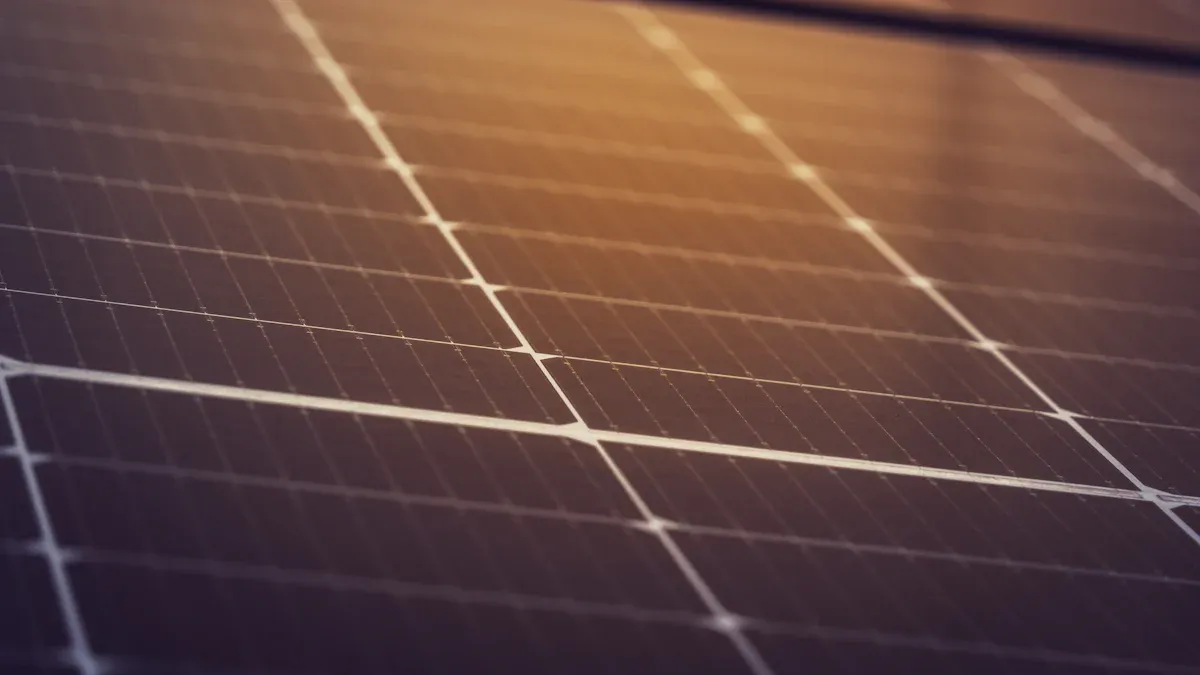
Multijunction solar cells are more efficient. They can reach up to 40% efficiency in labs. Single-junction cells usually get 19-25% in real-world use. The table below shows the latest efficiency numbers for both types.
| Solar Cell Type | Efficiency Range (Commercial) | Efficiency Range (Laboratory) |
|---|---|---|
| Single-Junction Silicon Cells | 19-25% | Up to 26.7% |
| Multi-Junction Cells | ~40% (limited commercial use) | Over 47% (lab, concentrated) |
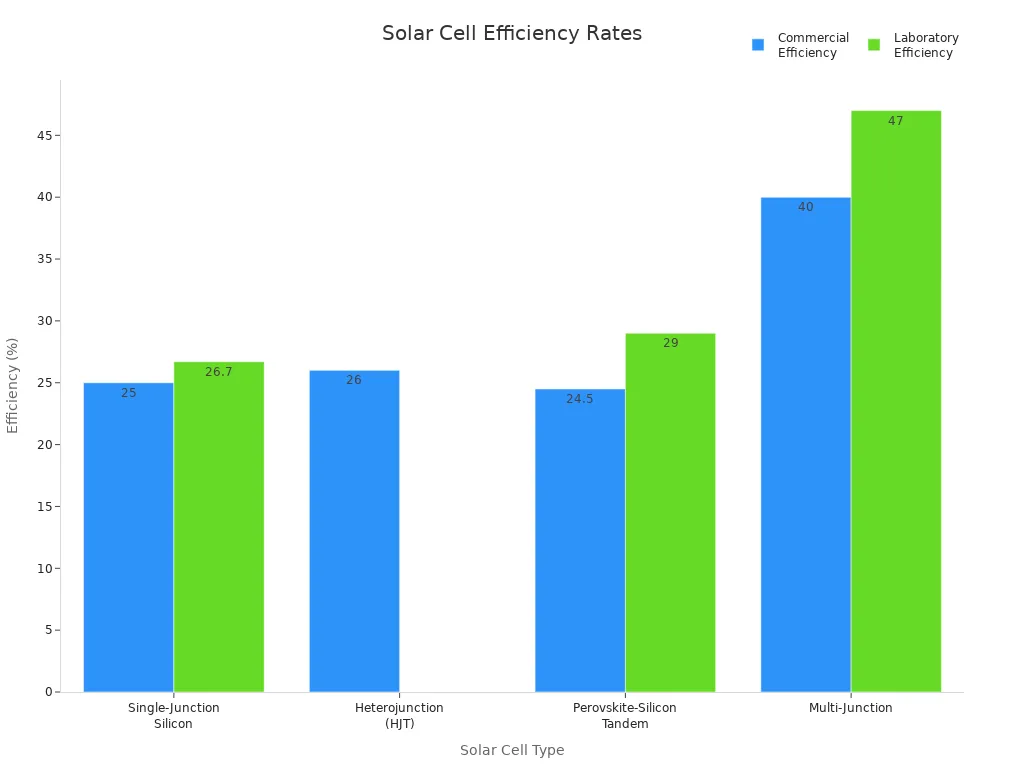
How well a solar cell works depends on what you need. If you want the best efficiency for special jobs, pick multijunction solar cells. If you want cheaper solar power for your home or business, single-junction cells are a good choice.
Multijunction solar cells have many layers to catch more sunlight. They work better than single-junction cells. They are great for space and strong sunlight.
Single-junction solar cells cost less and are simple to make. People use them a lot in homes and businesses. They are a good mix of price, strength, and steady work.
Multijunction cells work best in tough places and where there is lots of radiation. They cost more and are not used much on normal rooftops.
Single-junction cells do well with changing weather and sunlight. They are good for most outdoor uses and big solar farms.
Picking between these cells depends on your money, sunlight, and what you need. Single-junction cells are best for most people. Multijunction cells are best if you need high efficiency or special uses.
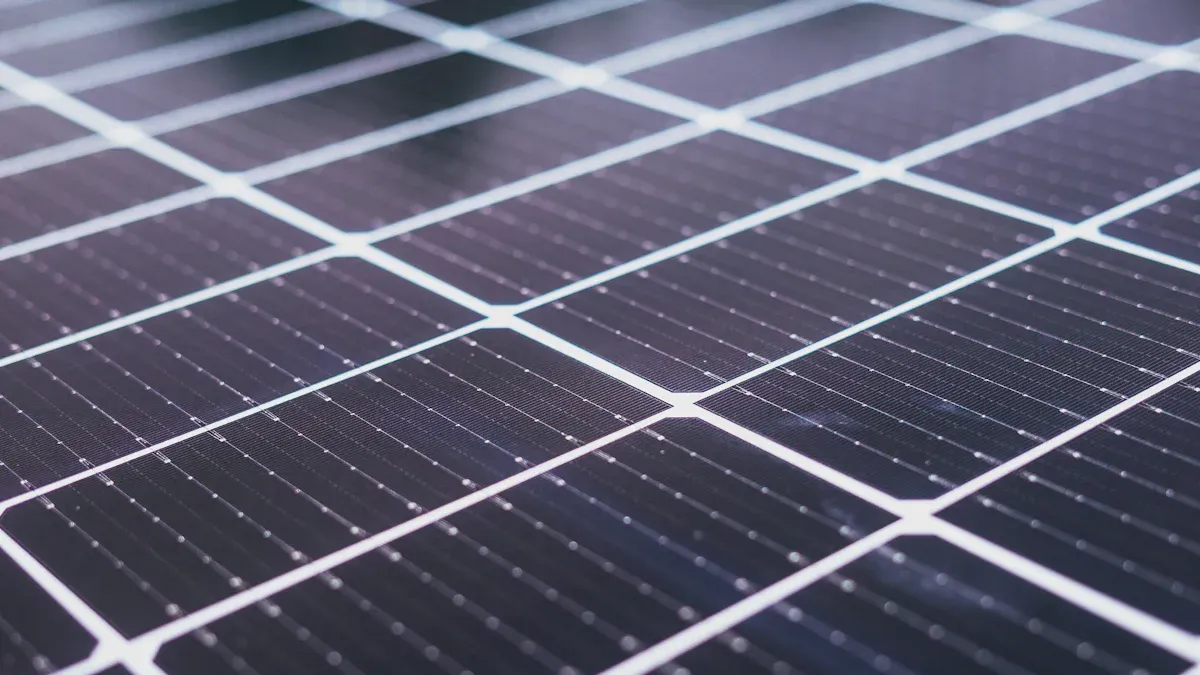
Multi-junction solar cells are known for high efficiency. They have several layers made from different materials. Each layer takes in a certain part of sunlight. This helps them collect more energy than single-junction solar cells. In 2023, scientists at Fraunhofer ISE and AMOLF set a new record. Their multi-junction solar cell reached 36.1% efficiency in the lab. They used a silicon TOPCon cell with gallium indium phosphide and gallium indium arsenide phosphide. A special metal and polymer coating helped trap more light. This made the cell more efficient than any other silicon-based multi-junction solar cell before.
Multi-junction solar cells could be even better in theory. With three junctions, they might reach about 48.8% efficiency. Adding more layers can make them even better. Six-junction cells could get up to 54%. If you use lots of layers and focus sunlight, efficiency could go past 65%. But in real life, things like material quality and temperature changes lower the results.
| Number of Junctions | Theoretical Max Efficiency (Detailed Balance) | Practical Efficiency Limits | Key Limiting Factors |
|---|---|---|---|
| Approaching infinity | >65% (no concentration), >85% (with concentration) | N/A | Idealized conditions, no optics or interconnection losses |
| 3 | ~48.8% | ~48.8% (97% of limit) | Availability of low band gap (~0.9 eV) bottom cell materials |
| 4 | ~51.2% | ~51.2% (96% of limit) | Spectral variations causing current mismatch in series connection |
| 5 | ~52.8% | ~52.8% (94% of limit) | Optical losses, economic constraints favor ≤5 junctions |
| 6 | ~54.0% | ~54.0% (93% of limit) | Temperature variations, imperfect optics, spectral mismatch |
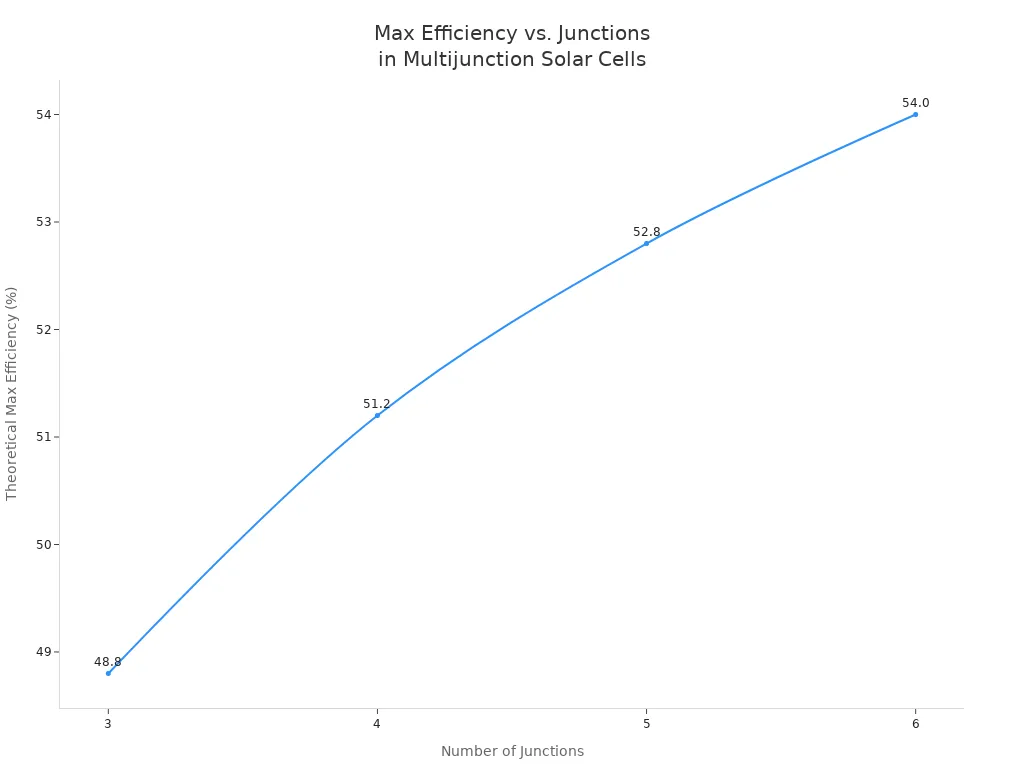
Multi-junction solar cells use special materials. Some examples are gallium indium phosphide, gallium indium arsenide phosphide, and silicon. These materials help each layer take in a different part of sunlight. By splitting sunlight, they lose less energy. This makes them much more efficient than single-junction solar cells. Triple-junction cells can get over 40% efficiency with focused sunlight. Six-junction cells have reached above 47% in labs. Being able to use more of the sunlight is why they work so well.
Single-junction solar cells have only one layer to take in sunlight. Most are made from crystalline silicon. These cells are used in about 95% of solar panels today. There is a limit called the Shockley-Queisser limit for how good they can be. For silicon, this limit is about 33.7%. Most single-junction solar cells you can buy are 19-25% efficient. Some special types, like gallium arsenide cells, can reach up to 25.5%. But these are more costly and not as common as silicon cells.
| Material | Usage in Single-Junction Solar Cells | Typical Efficiency Range | Cost and Other Notes |
|---|---|---|---|
| Crystalline Silicon (Si) | Most common (~95% of modules sold) | Around 15-20% typical; high efficiency | Low cost, abundant, long lifetime (25+ years) |
| Gallium Arsenide (GaAs) | Less common but important | Typically 20-25%, with advances up to ~24.3-25.5% | Higher cost, higher efficiency, better in harsh conditions |
| Amorphous Silicon (a-Si-H) | Less common, thin-film technology | Lower than crystalline Si | Versatile but less efficient |
| Cadmium Telluride (CdTe) | Thin-film, second most common after Si | Lower than Si | Cost-effective manufacturing, less efficient |
| Copper Indium Gallium Diselenide (CIGS) | Thin-film, emerging technology | High lab efficiencies but complex manufacturing | Requires more protection than Si |
| Perovskites | Emerging thin-film technology | Lab efficiencies improved from 3% (2009) to >25% (2020) | Still developing durability and manufacturing methods |
| Organic Photovoltaics (OPV) | Emerging, flexible applications | About half as efficient as crystalline Si | Shorter lifetime, potentially lower cost |
| Quantum Dots | Experimental | Currently low efficiency | Easy to make, customizable bandgap |
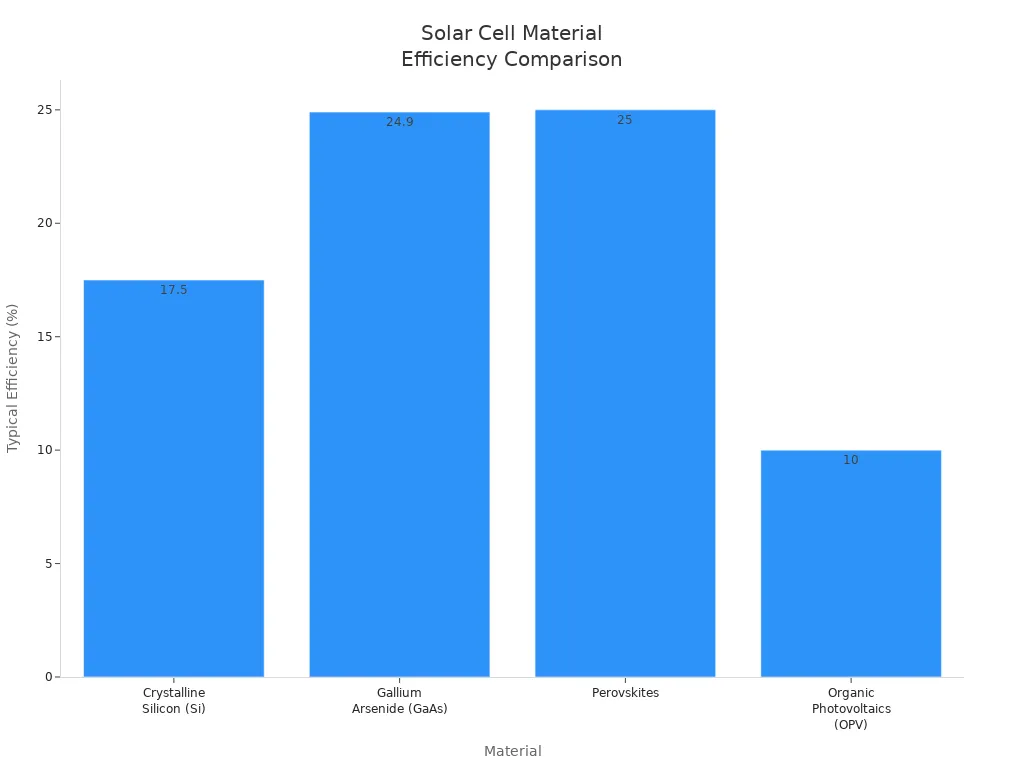
The Shockley-Queisser limit was set in 1961. It explains why single-junction solar cells cannot turn more than about one-third of sunlight into electricity. This is because one layer cannot use all the energy from sunlight. Some light does not have enough energy to make electricity. Some has too much and turns into heat. Scientists are still working to make single-junction solar cells better. But most products are still below the best possible efficiency.
Multi-junction and single-junction solar cells work differently outside the lab. Multi-junction solar cells are better at handling tough conditions. This makes them great for space missions and satellites. But their efficiency can drop if sunlight does not hit all layers the same way. Tests show that uneven sunlight can lower their output by over 40%. Making sunlight spread out better can raise efficiency from about 22% to 37%. Hot spots and temperature changes can also hurt performance. Careful design can help fix these problems.
Single-junction solar cells, especially silicon ones, work well in most outdoor places. Their efficiency stays steady in normal conditions. But they can wear out faster than multi-junction cells in high radiation, like in space. The quality of materials and how the cells are made matter a lot. The match between the cell's bandgap and sunlight also affects how well they work.
Many things affect the difference in performance between the two types:
The voltage and quality of each layer in multi-junction solar cells are important.
Current matching between layers is needed for multi-junction solar cells.
Material quality, especially in complex cells, can cause losses.
The design should match the sunlight spectrum for best results.
Tunnel junctions and resistance can lower performance, especially with focused sunlight.
Better manufacturing can help close the gap between lab and real-world results.
Note: Multi-junction solar cells are more efficient because they use more parts of sunlight. Each layer takes in a different part, so less energy is lost. This gives them an advantage over single-junction solar cells, especially when light is controlled or focused.
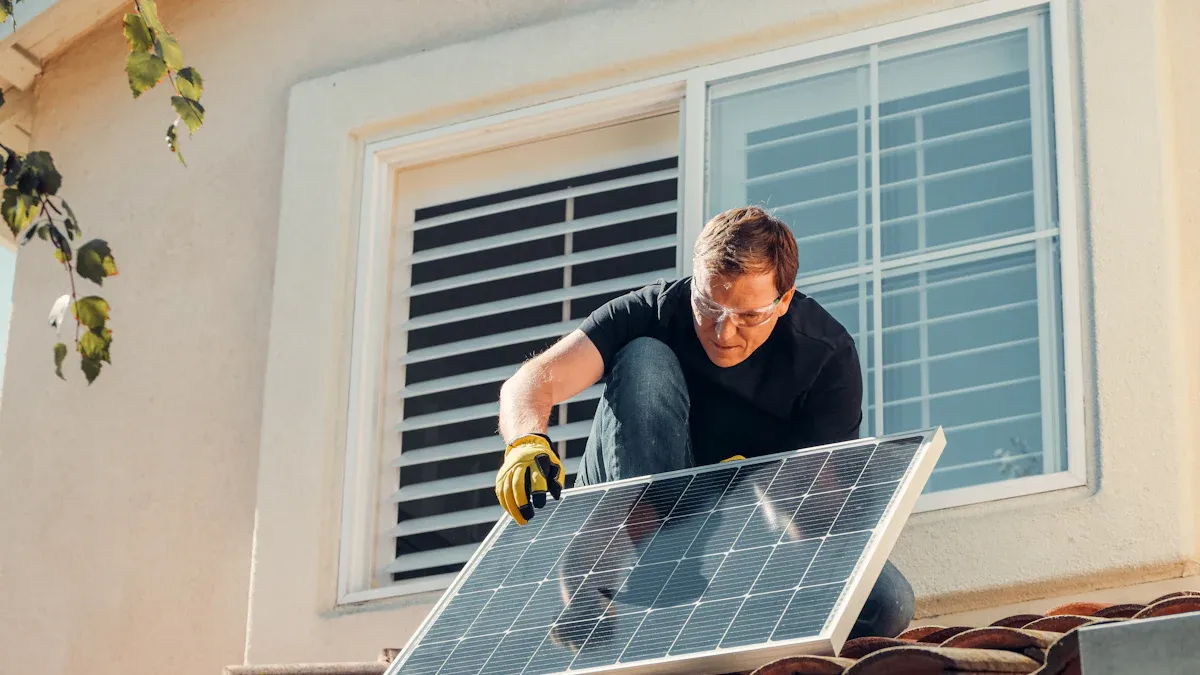
Multi-junction solar cells are used for tough jobs. They work well in space because they are light and strong. Engineers put them on satellites and Mars rovers. These cells can handle strong radiation and big temperature changes. Their light weight helps save money when sending things to space.
On Earth, multi-junction solar cells are used in CPV systems. These systems use mirrors or lenses to focus sunlight. The focused light is much stronger than normal sunlight. This lets the cells make more electricity from a small area. They are good for projects that need lots of power but have little space.
Note: Multi-junction solar cells are not common in regular solar panels. They cost a lot and are hard to make. People use them when they need the best performance, not the lowest price.
Common applications for multi-junction solar cells:
Spacecraft and satellites
Mars rover missions
Concentrated photovoltaic (CPV) power plants
High-performance, niche energy systems in harsh environments
These cells are very good at handling radiation. They also work well when it gets hot or cold. This makes them great for hard places, but they are not used much on Earth.
Single-junction solar cells are used in most homes and businesses. Monocrystalline silicon cells are on many rooftops and solar farms. They are popular because they are cheap, last long, and work well.
People use single-junction solar cells in flexible panels and chargers. Some space devices use them too. In space, engineers sometimes pick single-junction III-V cells like gallium arsenide. These cells work well and can handle space conditions.
| Technology Type | Efficiency Range (Commercial) | Key Advantages for Rooftop Installations | Suitability for Residential/Commercial Rooftops |
|---|---|---|---|
| Single-junction Silicon | 15-23% (some lab >24%) | Back Contact moves wiring to back, improves light capture, better performance in limited space, partial shading, harsh weather | Dominant technology, highly suitable for residential rooftops |
| Tandem (Silicon + Perovskite) | Approaching 35% (R&D phase) | Higher energy yield from same roof area, better in space-constrained/shaded environments | Emerging tech, promising for future rooftop use |
| Perovskite Single-junction | Close to 30% | High efficiency, excellent temperature performance, low manufacturing cost, flexible and lightweight | Potential for residential and commercial rooftops, still maturing technology |
| Multi-junction Cells | Over 47% (lab) | Very high efficiency but costly and complex | Limited to specialized applications, not common for rooftops |
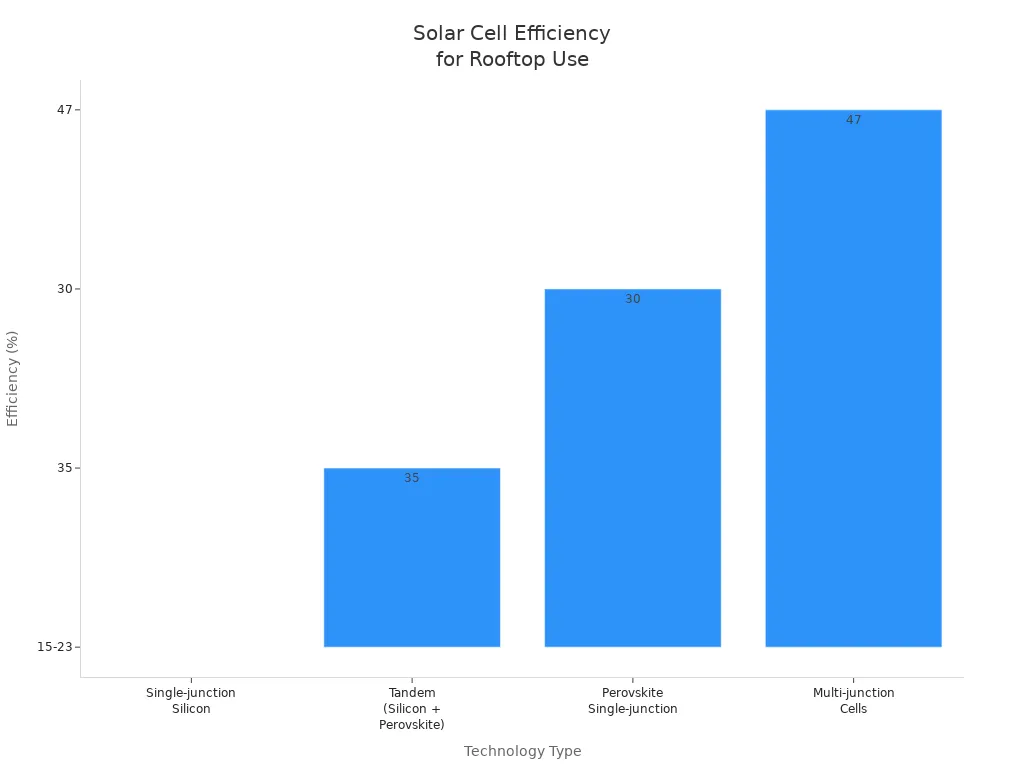
Single-junction solar cells are easy to make and use. They are reliable and not expensive. Their simple design helps factories make lots of them. Most people pick these cells for their roofs because they work in many places.
How much solar cells cost and how many can be made is important. Single-junction solar cells, especially silicon ones, are cheap to make. Factories can make many at once, so prices stay low. They use simple parts and common materials.
Multi-junction solar cells are harder to make. They need special steps and rare materials like gallium arsenide and germanium. Making them takes special tools and clean rooms. This makes them cost more. Because they are hard to make, factories cannot make as many.
| Aspect | Single-Junction Silicon Solar Cells | Traditional Multijunction Solar Cells |
|---|---|---|
| Efficiency | 15-20% | Above 40%, theoretical up to 50% |
| Manufacturing Cost | Relatively low, industry standard | Very high, limits use to niche applications (e.g., satellites) |
| Scalability | High, due to low cost and established manufacturing | Low, cost-prohibitive for large-scale deployment |
| Manufacturing Innovation | Standard silicon wafer processing | Complex layering of different semiconductors |
| Market Impact | Widely used in commercial solar panels | Limited to specialized, high-cost applications |
| Cost Trend with Volume | Costs decrease with scale | Costs remain high due to complexity |
Tip: New ways to make multi-junction solar cells may lower their price. This could help more people use these high-efficiency cells in the future.
Multi-junction solar cells are more sensitive to changes in sunlight. Each layer uses a different part of the light. If the sunlight changes, some layers may not work well. This lowers the total power. These cells are not as steady in places with changing weather. Single-junction solar cells handle sunlight changes better, so they work well every day.
Multi-junction solar cells work really well. They have many layers that each catch a different part of sunlight. This helps them get very high efficiency, especially in special places.
Main Advantages:
They can be very efficient, often over 40% in labs.
They use more sunlight, so less energy is wasted.
They are light and strong, which is good for space.
They do well with strong sunlight when using lenses or mirrors.
They can handle radiation and big temperature changes.
Their flexible designs help in tough or advanced places.
Main Disadvantages:
They cost a lot to make because of rare materials and hard steps.
Making them needs special tools and careful work.
Some parts can wear out faster, so they may not last as long.
Problems getting materials can make them hard to find.
They are best for space or special solar power, not for most roofs.
Note: Scientists are working to make these cells cheaper and stronger. This could help more people use them in the future.
Single-junction solar cells are the top pick for homes and businesses. Their simple design and proven use make them easy and dependable.
Main Advantages:
They cost less to make and put in than multi-layer cells.
Their simple shape makes them quick and easy to set up.
They work well and stay steady for many years.
Strong materials keep them safe from weather and harm.
People trust them because they have worked for a long time.
Main Disadvantages:
They cannot go above about 33% efficiency because of a limit.
Only one layer takes in sunlight, so some energy turns to heat.
They are not as bendy or useful in different shapes as some new cells.
They do not work as well in space or other tough places.
Tip: Single-junction solar cells are best for most homes, schools, and businesses. They give a good mix of price and how well they work.
| Feature | Multijunction Solar Cells | Single-Junction Solar Cells |
|---|---|---|
| Typical Efficiency (Lab) | Up to 47% | Up to 27% |
| Typical Efficiency (Commercial) | ~40% (special uses) | 19–25% |
| Cost | High | Low |
| Durability | Good in space, less on Earth | Excellent (25–30 years) |
| Best Use | Space, CPV, special projects | Homes, businesses, solar farms |
| Flexibility | High (can be lightweight, bendable) | Low to moderate |
| Market Availability | Limited | Very common |
Picking multijunction or single-junction solar cells depends on what you need. Multijunction cells work best for space or special jobs. They are very efficient but cost more and use rare materials. Single-junction cells are better for most homes and businesses. They are cheaper, easy to use, and last a long time.
When choosing solar panels, people should think about:
How much money they want to spend
How much sunlight their area gets
What they will use the panels for, like roofs or space
In the future, new ideas may help both types work better and cost less. This could make solar power easier for everyone to use.
Multijunction solar cells have many layers. Each layer takes in a different part of sunlight. This helps them get more energy from the sun. Single-junction cells have just one layer. They cannot use all the sunlight, so some energy is lost.
Most people use single-junction silicon panels at home. Multijunction cells are more expensive and need experts to install them. They are best for space or special uses, not for most rooftops.
Factories use common materials like silicon to make single-junction cells. The way they are made is easy and quick. This keeps the price low. Multijunction cells need rare materials and careful steps.
Multijunction cells do not work as well when sunlight changes. Clouds can make each layer work less. Single-junction cells do better on cloudy days.
Most single-junction panels work for 25 to 30 years. Multijunction cells also last a long time, especially in space. On Earth, how long they last depends on where and how they are used.
